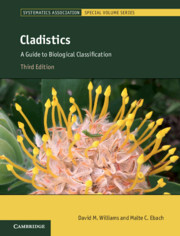Book contents
- Cladistics
- The Systematics Association Special Volume Series
- Cladistics
- Copyright page
- Dedication
- Contents
- Preface
- Acknowledgements
- Introduction: Carving Nature at Its Joints, or Why Birds Are Not Dinosaurs and Men Are Not Apes
- Part I The Interrelationships of Organisms
- Part II Systematics: Exposing Myths
- Part III The Cladistic Programme
- Part IV How to Study Classification
- Part V Beyond Classification
- Afterword
- Index
- Systematics Association Special Volumes
- References
Introduction: Carving Nature at Its Joints, or Why Birds Are Not Dinosaurs and Men Are Not Apes
Published online by Cambridge University Press: 20 July 2020
- Cladistics
- The Systematics Association Special Volume Series
- Cladistics
- Copyright page
- Dedication
- Contents
- Preface
- Acknowledgements
- Introduction: Carving Nature at Its Joints, or Why Birds Are Not Dinosaurs and Men Are Not Apes
- Part I The Interrelationships of Organisms
- Part II Systematics: Exposing Myths
- Part III The Cladistic Programme
- Part IV How to Study Classification
- Part V Beyond Classification
- Afterword
- Index
- Systematics Association Special Volumes
- References
Summary
The phrase in the title above – ‘carving nature at its joints’ – comes from Plato’s Phaedrus asking how and why people ‘carve-up’ and partition the organic world in the way they do. In short: “How do we classify the world?” There are, of course, many ways to classify, but the central question for biology is why are some groups of organisms, such as birds, recognised as real groups, when others, such as invertebrates, are rejected as such? This, of course, begs an additional question as to what ‘real’ might mean in terms of classification.
- Type
- Chapter
- Information
- CladisticsA Guide to Biological Classification, pp. 1 - 10Publisher: Cambridge University PressPrint publication year: 2020
References
- 1
- Cited by

